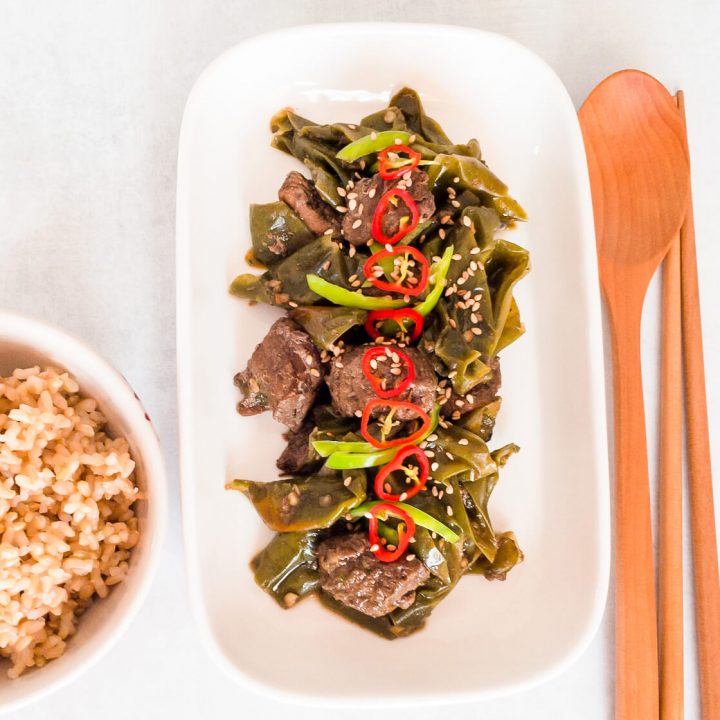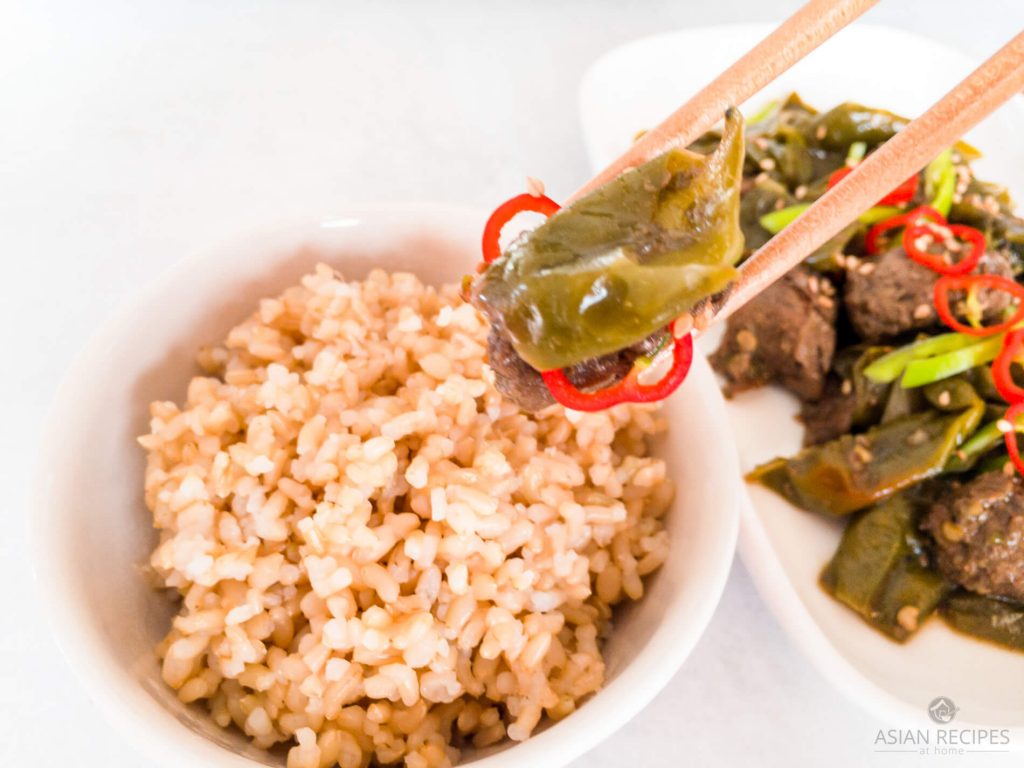This Korean soy sauce braised beef recipe is so easy to make. The result is beef that is tender, slightly sweet and crave-worthy saltiness.
Our soy sauce braised beef recipe
A lot of recipes tend to use cuts of beef like beef eye round, brisket, or flank steak. However, we are using stew meat for our recipe. Beef stew meat is usually a bit cheaper than the other cuts of meat. It is also already cut into tiny chunks so that work is already done. Feel free to swap out the pound of meat for a cut you prefer if you rather not use stew meat. The cooking time may vary depending on the cut of meat you choose to use and make sure to cut the beef into smaller chunks.
When beef was rare in the old days, jangjorim was a cost-effective method to feed the entire household. It’s also a popular side dish for lunches made at home.
Ingredients needed for this delicious braised beef
- Beef stew meat – We liked using the already cut meat for ease. If you prefer, feel free to use beef eye of round, brisket, or flank. Just make sure you cut it into chunks and you may need to adjust your cooking times until the beef is tender.
- Water
- Mild long green peppers – My mom actually grows her own peppers. You can typically find fresh peppers in Asian or Korean markets. You can also use shishito peppers.
- Yellow onion
- Garlic
- Toasted sesame seeds
- Red pepper (optional) – We sliced a fresh red pepper for garnish when serving. This is optional.
- Banana pepper (optional) – Again, we used one small banana pepper as garnish. You don’t have to do this to enjoy this dish.
For the sauce:
- Plum wine – We used this in place of sugar you’ll find in a lot of traditional recipes online. We have some other recipes that use plum wine, so don’t worry it won’t go to waste. If you can’t get your hands on plum wine, then you could also use white cooking wine.
- Dasida beef soup stock powder – This provides great umami flavor to the dish and is used in a lot of our recipes.
- Fish sauce
- Salt
- Ground black pepper
- Soy sauce – Soy sauce is a must to provide the dish with that saltiness that is crave-worthy.
- Coconut aminos – This also provides a bit of natural sweetness to the dish. A great salty and sweet addition to the sauce.
- Seasoning sauce
How to serve this braised beef
Jangjorim can be served cold, at room temperature, or warmed in the microwave. Due to its saltiness, it’s typically used as a side dish. Serve it with freshly steamed rice, or alongside any Korean meal.
How to store soy sauce braised beef
This dish can be stored in the refrigerator for several days up to a week. The salt really helps to preserve the meat.
HUNGRY FOR MORE? Subscribe to our newsletter and follow along on Facebook, Pinterest, Twitter, and Instagram for all of the latest updates.

Soy Sauce Braised Beef with Green Peppers (Jangjorim)
This Korean soy sauce braised beef recipe is so easy to make. The result is beef that is tender, slightly sweet and crave-worthy saltiness.
Ingredients
- 1 lb beef stew meat
- 3 cups water
- 3 cups mild long green peppers (found in Asian markets), diagonally sliced (can keep seeds)
- ½ cup yellow onion, chopped
- 1 teaspoon garlic, minced
- 1 teaspoon toasted sesame seeds
- 1 red pepper, for garnish (optional)
- 1 banana pepper, for garnish (optional)
- For the sauce:
- 1 Tablespoon plum wine (or white cooking wine)
- 1 Tablespoon Dasida beef soup stock powder
- 2 teaspoons fish sauce
- 2 teaspoons salt
- 1 teaspoon ground black pepper
- ¼ cup soy sauce
- 2 Tablespoons coconut aminos
- 1 Tablespoons seasoning sauce
Instructions
- Bring the 3 cups of water to a boil in a pot and then add the beef stew meat. Turn the heat down to medium-high heat. Cook for about 40-50 minutes, or until the beef turns tender, with a lid slightly cracked. Note: To test whether the beef is tender enough, poke it with a fork. The fork should easily go through the meat.
- Skim the scum off the top of the broth, if necessary. Add in the sauce ingredients.
- Next, add the sliced green peppers, garlic, and onions to the pot, and continue cooking for about 30 minutes with the cracked lid. About every 5 minutes, turn the peppers and onions over. Try to bring the bottom peppers and onions to the top and the top peppers and onions to the bottom.
- Continue cooking, turn the heat down to low heat and remove the lid. Let the juices evaporate for about 5-10 minutes. there should only be about ¼ cup of liquid left in the pot.
- Garnish the top with fresh sliced red and banana peppers just before serving (optional). Sprinkle toasted sesame seeds on top. Enjoy!
We love seeing your creations from our recipes! Tag us on Instagram at @AsianRecipesAtHome.
Disclaimer: Under no circumstances shall this website and the author(s) be responsible for any loss or damages resulting from the reliance of the given nutritional information or ingredient/product recommendations. Recommended ingredients/products can change their formula at any time without this website and author’s awareness. It is your responsibility (the reader’s) to check the label/ingredients of any product prior to purchasing and/or using. We greatly appreciate your support and understanding.


